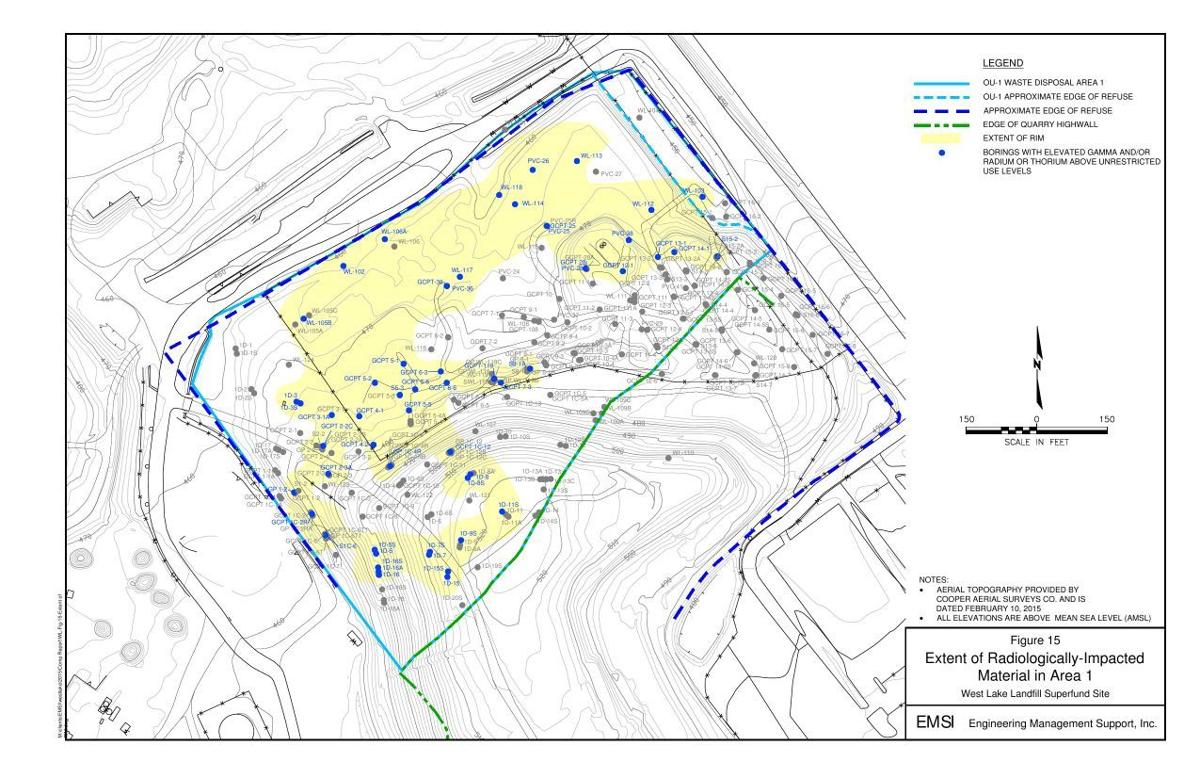St. Louis Post-Dispatch
by Jacob Barker

After almost a year of study, the Environmental Protection Agency says it believes it has completely mapped the extent of radioactive contamination at the West Lake Landfill.
The findings come as the agency works to finalize plans for a barrierseparating the burning Bridgeton Landfill from the adjacent West Lake Landfill, which was contaminated in the 1970s with uranium processing waste dating to the Manhattan Project.
Some of the material, mostly uranium decay products, was about 600 feet further south than prior EPA investigations had determined. That makes the distance between the fire and the radioactive waste only half as much as the agency’s prior studies indicated.
The new map puts some of the newly discovered material in the northern quarry of the Bridgeton Landfill. But a line of wells and other equipment is meant to control the fire’s spread, and the Missouri Department of Natural Resources has not raised any concerns in recent reports that the fire is spreading.
“While the footprint of the (radiologically impacted material) has changed … there’s still no significant health risk posed by the radioactive waste at the West Lake Landfill,” Brad Vann, the EPA official overseeing the West Lake project, said during a call with reporters. “The health risk for both on-site workers and those off site hasn’t changed.”
The waste is in similar concentrations to what has already been identified in the landfill, the EPA said. And it’s not the first EPA investigation to identify radiological contamination beyond the chain-link fence surrounding West Lake.
The newly discovered material beyond the fence is well below the surface, Vann said, posing little risk for exposure. Landfill owner Republic Services still operates a waste transfer station near some of the contamination, but the general public isn’t allowed to access the site. Procedures are in place to protect workers, Vann said.
When the EPA and the Army Corps of Engineers began looking for a path to build an underground wall in 2014, they realized they needed to better map the waste to find a clear line for the barrier. Vann said the agency doesn’t believe the waste moved over the years. Prior investigations just didn’t catch it.
Now, the agency says it has identified a clean path to build a wall. It hopes to begin construction next year after finalizing engineering plans and a legal agreement with landfill owner Republic Services.
Residents have waited more than two years for a barrier separating the smoldering fire discovered in 2010 from the contaminated West Lake Landfill. Some, angry that West Lake has spent more than 25 years on EPA’s Superfund list without resolution, have pushed to transfer cleanup to a special Army Corps of Engineers program. A bill authorizing the transfer passed the U.S. Senate last month.
Missouri Attorney General Chris Koster, the Democratic candidate for governor, released a statement criticizing EPA for not yet having final barrier plans and calling for the corps to take over cleanup at the site.
“Today’s report confirms that EPA has never had a clear picture of the extent of contamination at the West Lake landfill, and it is deeply concerning that it took EPA so long to figure that out,” Koster’s statement said.
The EPA proposed capping West Lake in 2008, but backlash from residents and activists who wanted the radioactive waste hauled out prompted the agency to reconsider its decision and undertake additional study. The EPA says it will propose whether to cap or excavate the radioactive waste in West Lake by the end of the year.
After being sued by Koster in 2013, Republic Services has installed more than $100 million in infrastructure to control the burning and treat contaminants. Company spokesman Richard Callow said in a statement that the study provides a better picture of the extent of contamination and that the radioactive material isn’t threatened by the burning landfill.
“That seems like a good and important step toward reaching a final decision by the end of year,” Callow wrote. But there’s still no construction schedule, barrier design or legal agreement mandating the project.
